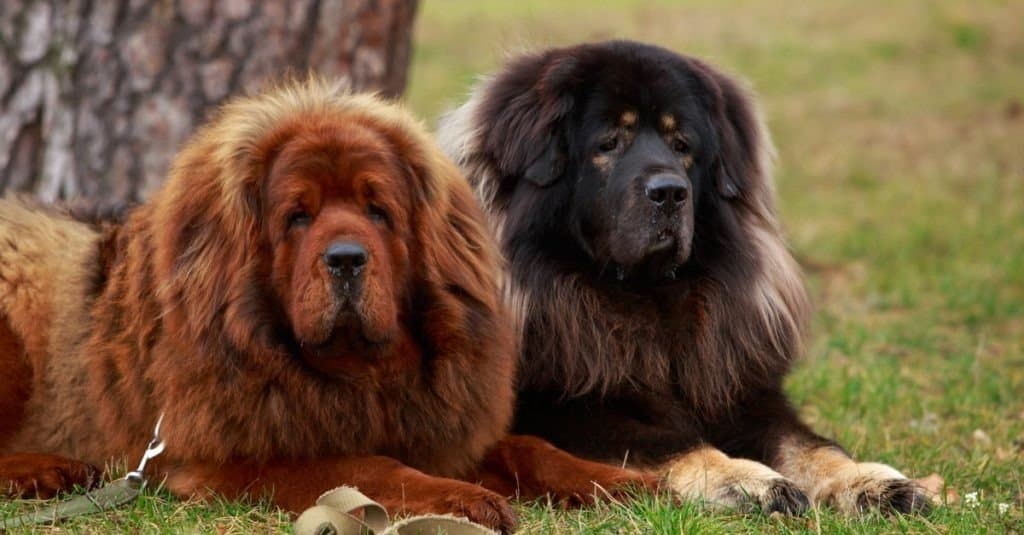The mighty Tibetan Mastiff has a heart just as large as their stature! Their size may be daunting to some, but these pups are known to be affectionate and loving family dogs. They were originally bred to guard properties in the frigid Himalayan terrain, and those innate guarding instincts have transferred over to their life today.
The Tibetan Mastiff can be very protective of their family and their property when strangers are around, but they often warm up quickly once they realize the interaction is safe. The Tibetan Mastiff is incredibly devoted to those they love most!
Once you decide that a Tibetan Mastiff is the right dog for your family, you may wonder if you should adopt a male or female. There are a five main differences between the male and female Tibetan Mastiff, so let’s discuss everything you need to know below!
#1 Physical Differences

The Tibetan Mastiff can weigh anywhere from 75 to 160 pounds. Males tend to be heavier than females.
©Svetography/Shutterstock.com
Like most other dog breeds, the male Tibetan Mastiff’s physical features are often more prominent than the female’s features.
Male: Male Tibetan Mastiffs are often larger than females. Male Tibetan Mastiffs are often 15 pounds heavier than females, with their average weight range being 100 to 160 pounds. Males are often more muscular and stocky then females as well.
Female: Female Tibetan Mastiffs tend to be a bit smaller than males. While males can weigh anywhere from 100 to 160 pounds, females tend to weigh 75 to 125 pounds on average.
#2 Temperamental Differences

The Tibetan Mastiff is known for being loyal, protective, and devoted to their loved ones.
©Svetography/Shutterstock.com
Both genders of the Tibetan Mastiff are often very affectionate and calm, but male Tibetan Mastiff’s can display more territorial aggression when unknown people and dogs are around.
Male: The male Tibetan Mastiff is known for having a strong sense of self. They are stubborn and intelligent, so this can lead to a bit of stubbornness. While both genders of this Mastiff are protective and loyal, males tend to take their guardian roles a bit more seriously. Their protectiveness and territorialism will be even more intense if they are intact (not yet neutered). Males are also a bit more calm and reserved in their homes.
Female: Female Tibetan Mastiffs are a bit more playful and energetic than males. Females share the same protectiveness as males, but these tendencies are often more reserved during the daytime. However, your female Tibetan Mastiff may bark and attempt to guard your home during nighttime hours. Their territorialism will also increase if they are not yet spayed.
#3 Trainability Differences

The Tibetan Mastiff requires a skilled and confident pet parent to guide them through their obedience training.
©Olga Aniven/Shutterstock.com
Both the male and female Tibetan Mastiff are stubborn and challenging to train. They require a skilled and confident pet parent to guide them through their obedience training. However, there are a few slight differences between male and females that impact their training.
Male: It is crucial to socialize your Tibetan Mastiff as soon as you welcome them into your home. Male Tibetan Mastiffs can struggle with territorial aggression due to their protective instincts, so it’s essential to introduce them to as many people, animals, and unfamiliar environments as possible. With how massive the male Tibetan Mastiff can be, it’s important to make sure they are well-rounded and comfortable around new things!
Female: The female Tibetan Mastiff is a bit more sociable than their male Mastiff friends. However, it’s still important to introduce them to obedience training and socialization early on. Their training is made easiest when it is implemented as young as possible.
#4 Health Differences

Tibetan Mastiffs are prone to experiencing hip dysplasia, arthritis, cardiac disease, elbow dysplasia, panosteitis (growing pains), and hypothyroidism.
©Kat_marinina/Shutterstock.com
Both the male and female Tibetan Mastiff have an average lifespan of ten to 14 years. They are known to suffer from issues such as hip dysplasia, arthritis, cardiac disease, elbow dysplasia, panosteitis (growing pains), and hypothyroidism.
Male: There are not many health differences in male vs. female Tibetan Mastiffs. However, intact male Tibetan Mastiffs can develop reproductive cancers and infections impacting their testicles, penis, and prostate.
Female: Intact female Tibetan Mastiffs can develop reproductive cancers and infections impacting their mammary tissues and uterus.
#5 Relationships With Other Dogs

The Tibetan Mastiff should be socialized early in puppyhood to prevent any future aggression towards other dogs.
©Tatyana Kuznetsova/Shutterstock.com
Both male and female Tibetan Mastiffs can get along well with other dogs when they are introduced to them early in life, or if they are well-socialized from puppyhood. However, introducing them to new dogs in adulthood can be challenging for intact males and females that are not well-socialized.
It’s also important to keep in mind that same sex aggression can make introduction to new dogs a bit challenging in the Tibetan Mastiff breed. These protective and loyal pups may perceive other dogs as a threat, causing them to display aggression. If you are welcoming an adult dog into your home with an adult Tibetan mastiff, it may be best to adopt a dog of a different sex. However, no matter how well-trained your Tibetan mastiff is, it’s important to approach the introduction process with patience and care.
Summary On The Male & Female Tibetan Mastiff
Male and female Tibetan Mastiffs may differ slightly when it comes to their temperament, physical appearance, training abilities, and health. Be sure to review the information above to determine which gender of Tibetan Mastiff is a good fit for your family!
The photo featured at the top of this post is © Tatyana Kuznetsova/Shutterstock.com
Ready to discover the top 10 cutest dog breeds in the entire world?
How about the fastest dogs, the largest dogs and those that are -- quite frankly -- just the kindest dogs on the planet? Each day, AZ Animals sends out lists just like this to our thousands of email subscribers. And the best part? It's FREE. Join today by entering your email below.
Thank you for reading! Have some feedback for us? Contact the AZ Animals editorial team.







